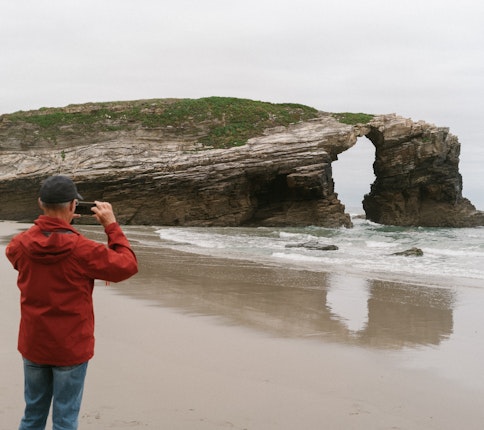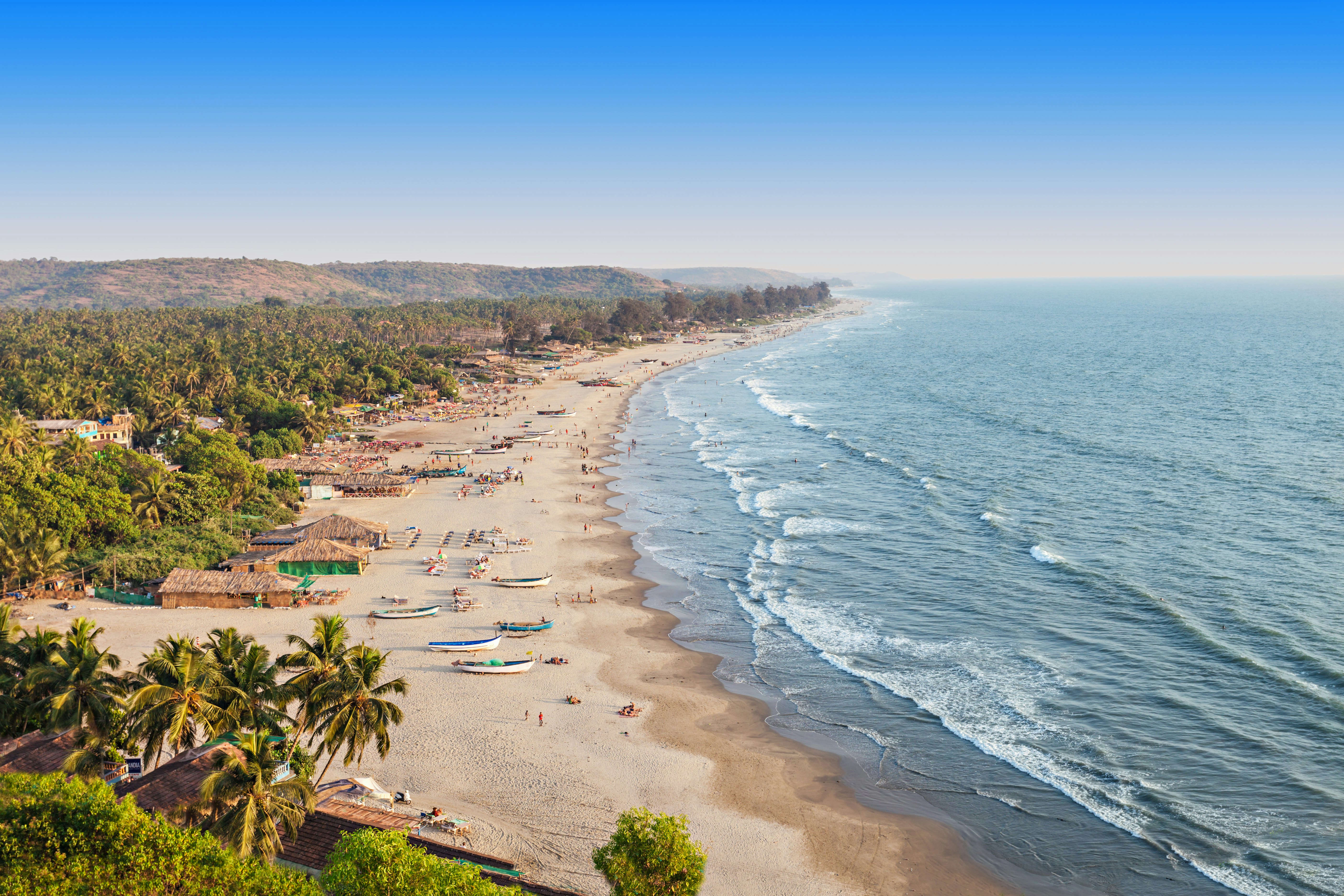
Find stunning beaches, a rich and varied history, delicious seafood and more in Goa.
If leisure had a poster child, it would be Goa.
One of India’s smallest states sits on the western coast, bordered by the Arabian Sea. It enjoys popularity for being a destination that offers something for every kind of traveler, from the hippies to the adventure junkies. Need a relaxing vacation? Check. Need to improve mental health and wellbeing? Check. Need to eat your weight in good food? Check. Need to party all night? Check. Need to immerse yourself in culture? Check. Need to get cozy with nature? Check. Goa will help you tick off every item on your to-do list.
Four centuries of colonial rule have fed into the state’s ethos, impacting every aspect of its identity. Goa may have changed dramatically through the years, but there is a new generation of Goans who are hard at work to showcase (and preserve) its traditions. This is a boon for locals, and travelers alike.
Good things come in small packages and Goa offers the best of a travel destination in one neatly wrapped, captivating package.
1. Drink in the local spirit
When in Goa, drink local. Goa’s state drink is feni, a potent homegrown spirit made with the juice of the cashew apple, or the sap of the coconut palm. Cashew feni is double distilled, and the first distillation yields a refreshing drink called urrak – also a hit, especially in summer months. These spirits are only found in Goa and are an integral part of the state’s identity. Start with urrak or a coconut feni, which are milder, or look for a feni cocktail in the nearest bar.
To learn more about this drink visit a cashew farm, Fazenda Cazulo, for a feni tasting conducted by Hansel Vaz. Vaz is the founder of Cazulo Premium Feni, and for a decade, has been working tirelessly to popularise this spirit and bring it recognition. There, you will learn about the process, see the instruments used, taste some expressions and understand how feni pairs with food.
Local tip: Goa is also home to a burgeoning craft spirits movement, and some distilleries like Paul John, Tamras, Maka di, and Goa Brewing Co, are open for tours.
2. Enjoy an intimate evening of Goan-Portuguese culture
Goans love two things with passion: football and music. If seeking a better understanding of the latter, step into a 200-year-old Goan home in Panaji. It’s a house that overlooks the river, and one section has been converted into the Centre for Indo-Portuguese Arts (CIPA).
Part of this is Madra Goa, a small room beautifully decorated with oyster shell panes, tiled awnings, printed umbrellas hanging from the ceiling, and the Goan ghumott (percussion instrument) and the Portuguese guitar. One wall has been painted to look like a street in Lisbon. It is in front of this “street” that celebrated Goan fadista (fado singer) Sonia Shirsat, accompanied by musicians (and sometimes, other fadistas) takes the stage for an intimate concert. Shirsat introduces each fado and mando and even guides the audiences into singing along. In the interval, snacks are sent around – plates of Indo-Portuguese fare such as bacalhau (salted cod fritters), pork empadinhas (pies), pastéis de nata (egg tarts), and choris (Goa sausages) pao.
Detour: Heritage Home Experiences also conducts cultural concerts featuring the band, Entre Nous, who sing different Goan musical stylings like mandos, dulpods, dekhni and fado.

3. See the preserved body of a centuries-old saint in Old Goa
Old Goa is certainly a must-do for anyone visiting Goa. The erstwhile capital of Portuguese India is home to many old, architecturally-beautiful churches, chapels and protected monuments, some of which are on the UNESCO World Heritage List. The biggest draw here is the Basilica of Bom Jesus, an imposing granite structure where you will find the body of St Francis Xavier, encased in a silver casket. The saint died in 1552 and for years, his body remains well-preserved. It is brought down for an exposition every decade for pilgrims to pay respects. This year is an exposition year, and festivities will continue for a month (21st November to the 5th January).
If you are there during the Exposition, don’t forget to pick up roasted gram, choris pao (sausage bread), and some khaje (a fried sweet of chickpeas and jaggery).

The best way to stay connected.
Saily provides a hassle-free solution to travel data — just choose your data plan and prepare for your trip. When you get to your destination, you can go online right away.
Get your eSIMDetour: The 17 CE Convent of Santa Monica in Old Goa houses the Museum of Christian Art (MoCA), an accessible museum showcasing Indo-Portuguese art sourced from churches and private collections.
4. Celebrate a monsoon festival in the state’s off-season
The monsoon months of June to September are typically off-season, and bring with them a slew of festivals that aren’t just religious, but incorporate and honour the environment too.
It starts with São João in June, where people celebrate the feast of St. John de Baptist by jumping into water bodies. Sangodd celebrates Goa’s fishing community, and the feast of Saints Peter and Paul, and includes a parade too. Chikal Kalo sees the male villagers of Marcel play games in the mud, which they believe Hindu deity Krishna played as a child. In August, the island of Divar celebrates a festival of flags called Bonderam – it includes a parade, much song and dance and mock fights between people where they try to knock down each other’s flags.
Local tip: Goan tour group, Soul Travelling, conduct tours offering visitors an in-depth look at these festivals.

5. Learn to surf on Goa’s beginner waves
Surfing is slowly becoming a popular sport in Goa. There are surf schools dotting Morjim, Ashvem and Mandrem in the North and Agonda in the South offering one-off classes, and training. Surfing in Goa is recommended because of its long coastline, a large number of surf schools, decent lifeguard infrastructure, and a gentle sea with mellow waves – surf teachers call them "beginner’s waves". Lessons are held in the morning and throughout the year, bar the monsoons. Popular surf schools include Vaayu Surf and SUP, Banana Surf School, On Da Wave, Octopus Surf School, Surf Wala, Swell Cats Surf Club, and Mumu Surf School.
Planning tip: Surf schools like Surfwala, Vaayu Kula, and Banana Surf School offer accommodation options, and a place to eat/ drink.
6. Listen to some vinyl at the state’s only vinyl bar
Some smooth jazz, a delicious cocktail in hand, and a dog at your feet… if this sounds like a perfect evening, then For The Record-Vinyl Bar (FTR) in Panaji should be on your list. Started by vinyl lover, architect and musician Buland Shukla, FTR is an intimate space that prides itself on its music – all vinyls; drinks – championing Indian craft spirits and brews like mahua and feni; and food – features his experiments with fermentation. FTR regularly hosts listening sessions, and small concerts. Go there in the afternoon, and you will likely meet his friendly dog, Django.
Detour: Right next door is the workspace, gallery and store of Thomas Louis, often referred to as Thomas the Potter. His creations make for lovely gifts, and he regularly conducts pottery classes.

7. See a croc in the wild
While dolphin watching is a popular activity in Goa, a far more adventurous one involves riding along water bodies looking for crocodiles. Crocodiles are revered, and considered a guardian spirit in Goa. The freshwater mugger is common to the state, and can be found in the Cumbharjua Canal. A typical ride on this stretch introduces you to the backwaters, the thriving mangrove habitat in the canal, and the marine life it sustains, including birds, crabs and crocodiles. The latter are usually found sunbathing on the shore, camouflaging well with the mud. Though fearsome in sight, they are quite used to human presence.
Planning tip: John’s Boat Tours organizes a Crocodile Dundee: a 4-5 hour tour with birdwatching and snacks.
8. Go forest bathing in Mollem
Bhagwan Mahaveer Sanctuary is the state’s largest protected wildlife area, and home to Mollem National Park. The forest is part of the biodiversity hotspot that is the Western Ghats, and home to varied flora and fauna. Here, you can look for Goa’s state symbols: the state bird – a flame-throated bulbul, state animal – the gaur, and state tree – crocodile bark tree. Venture deep within the forest and you will find Goa’s oldest temple, the basalt Tambdi Surla. There are seasonal and perennial waterfalls, accessible by a short hike – the most popular is Dudhsagar.
Planning tip: If you fancy spending a night in the forest, without distraction, seek out Jungle Trails Homestay. A women-led homestay with basic facilities (no wifi or TV) with vegetarian food, they can organize bird-watching tours, and folk dance performances.

9. Brush up on your spice knowledge at a spice farm
It is one of those typical tourist activities to do in Goa, but a visit to a spice plantation doesn’t have to be boring. You start with a tour that introduces you to the spices that Goans love to cook with, including the tirphal (related to Sichuan pepper) and see some herbs and medicinal plants. The tour is typically followed by a Goan lunch. Many farms also offer that little extra. At Tanshikar Spice Farm, you get to see an old Goan mud house, with a cow dung floor and learn about the houses of the time. There are pools and water slides, and a zip line at Nandanvan Spice Farm. NV Eco Farm has wooden cottages for stay, and adventure activities like rock climbing and zip lining.
Detour: Step out of Kushavati Organic Farm, and you will find one of Goa’s oldest historic sites: the Usgalimal petroglyphs, dating back to the Stone Age.
10. Seek out a Goan village that resurfaces once a year
As villages go, Curdi certainly stands out for being the only one that remains submerged through the year, coming up for air in summer. Curdi was once a flourishing agricultural village. When the Selaulim Dam was built nearby, the village was one of many to be submerged by its waters. The villagers were moved out, but the skeleton of the village remains. Every summer, when Curdi resurfaces, villagers head back to celebrate their old home. You can visit Curdi on your own, and see the remains of the once flourishing village, including a chapel, a temple and some houses.
Detour: The Selaulim Dam lies a few kilometers away and is well-known for its main feature: a duckbill spillway.

11. Eat some fish, curry and rice
When in Goa, eat like the Goans. The staple meal here is fish, curry and rice. It’s a simple meal that utilizes the best that Goa has to offer – the bounty of the sea, local rice, and fish curries made with coconut, tirphal, local chillies, and kokum. These meals are found in most restaurants and some shacks but are best eaten at thali restaurants, small unassuming places serving fresh fish. A Goan thali has rice, curry, fried fish, some vegetables, a salad, kismur (dried shrimp salad) and solkadi (a digestive drink made with kokum). It’s a nourishing, filling meal that is best eaten by hand.
Detour: If seeking a delicious meal with a side of history, seek out Shubhra Shankwalker of Aai’s. The home chef organizes sit-down lunches at her farm, which feature an elaborate spread of Goan Saraswat food that is seasonal, and fresh.
12. Shop for food souvenirs at the local markets
Every avid traveler knows that the best way to understand a place is to visit its markets. Goa’s markets are an interesting riot of color, sound, and aromas. Most villages have a small market place, but the municipal markets in the cities are also worth a visit. Mapusa, Panaji, and Margao markets are divided into zones, dedicated to fish or fruit and vegetables, or flowers. These markets are a good option for those seeking food souvenirs – besides produce, you can also buy cheap but quality food souvenirs like cashew nuts and feni, Goa sausages, local bread, Goan sweets and snacks.
On Fridays, pay a visit to Mapusa’s market, which sees vendors from across Goa out to sell their wares.
Local tip: In May, many of the markets, like the one at Banastarim, also offer items for purumenth – the practice of stocking up for the monsoons – like dried fish, dried mango and jackfruit seeds, chillies, rice, pickles and more. During Chaturthi season, you will find the markets stocked with fruit, vegetables and herbs for the matoli, a wooden canopy suspended over the idol and laden with fresh produce.





